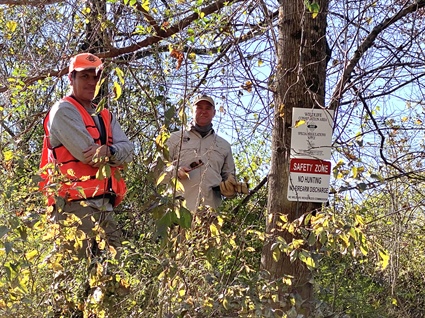
New Wildlife Conservation Area on French Broad River in Mills River
Mills River, NC -- The French Broad River floodplain is now home to a new wildlife area.
The 87-acre tract off NC Highway 191 is cleared and ready for restoration. Your generosity helped preserve this land, creating a place where wildlife can thrive and people can connect with nature.
Below:
Press Release announcing the new wildlife area in Mills River by the North Carolina Wildlife Resources Commission
*JOINT RELEASE*
RALEIGH, N.C. (Dec. 7, 2021) - Land along the French Broad River in Mills River is now a state Wildlife Conservation
Area and a planned natural floodplain restoration. In November, the N.C. Wildlife Resources Commission opened the
87-acre property to the public for fishing, birding, and other wildlife observation.
However, the property is a designated safety zone and hunting is not permitted.
Nick Shaver, the Mountain Region Supervisor of the Land and Water Access Division of the Wildlife Commission, says,
“This parcel is a new and unique opportunity for our agency to take what is virtually a blank slate and create some
high-quality wildlife habitat that will benefit both terrestrial and aquatic species.”
The site is known as King’s Bridge, taking its name from the bridge on NC Highway 191 over the French Broad River.
A small parking area is located on the east side of NC Highway 191, just south of the bridge.
However, there are no trails or other infrastructure on the property.
The King’s Bridge Wildlife Conservation Area has about two thirds of a mile of frontage along the French Broad River.
Future plans include public boat access and a natural floodplain restoration.
Like much of the floodplain along the French Broad River, the land has been drained to support agriculture.
The planned restoration will return it to a more natural state, with wet areas that bring back the natural flow of water between the land and the river.
Plans include one backwater slough, where fish and other aquatic life can rest and spawn outside the strong currents of
the river.
The land will also be regraded to a more natural shape, with a wide, low basin that can fill during flood events.
Restored wetlands will support many kinds of wildlife, including salamanders, turtles, birds, and mammals.
The restored floodplain will help filter water, improving water quality.
It will also allow the floodplain to fulfill its function of absorbing stormwater, thus reducing the severity of flooding downstream. By reducing the intensity of downstream flows, it will reduce bank erosion and sediment pollution.
The Kings Bridge Wildlife Conservation Area also provides a place for people to connect with nature—through fishing,
birding, wildlife watching, and river access—in a growing part of Henderson County.
The Wildlife Commission anticipates that it will take several years to complete the planned restoration.
The future boat access will go in after the planned widening of NC Highway 191 through this area.
Conserving Carolina purchased the property, a former sod farm, in December of 2020 and transferred it to the Wildlife Commission in the summer of 2021.
King’s Bridge is located just two miles upstream of Conserving Carolina’s Mouth of Mud Creek restoration site and twelve miles downstream of Conserving Carolina’s Pleasant Grove site.
Conserving Carolina worked with the Wildlife Commission, U.S. Fish and Wildlife, and other partners to complete a natural floodplain restoration at The Mouth of Mud Creek in 2020.
The land trust is now in the early stages of a floodplain restoration at Pleasant Grove.
Both of these restorations feature backwater sloughs, which are considered essential for the recovery of muskellunge,
or muskie, the largest fish native to the French Broad River.
David Lee, Conserving Carolina’s Natural Resources Manager, says “On their own, any one of these projects provides
essential benefits to the surrounding community, but together the benefits are compounded and more far-reaching.
Together, the floodplain conservation and restoration projects along the French Broad River will significantly improve
water quality, provide critical habitat for important aquatic and terrestrial species, and contribute to the overall resiliency of the river corridor.”
Funding to purchase the Kings Bridge property came from the National Fish and Wildlife Foundation, the U.S. Fish and Wildlife Service and philanthropists Fred and Alice Stanback. Private lenders also played a key role, providing loans to Conserving Carolina until permanent funding was secured. These private investors include Mary Fanslow, Randy Hall and Annie Keck-Hall, Tom and Susan McHugh, Fred and Lauren Weed, and Dale Weiler and Loti Woods.
Ben Copeland, Jr., the CEO of Supersod, which sold the land to Conserving Carolina, says, “This project was a great opportunity to further our company‘s culture and commitment to conservation and sustainability.
This is our fourth project with Conserving Carolina, among many others we have been involved with in three states. Conservation organizations like Conserving Carolina provide flexibility for our commitment of setting aside land for future generations through cash donations, partial value contributions, conservation easements or fee simple contributions.”
About Conserving Carolina
Conserving Carolina is a local land trust that has protected nearly 46,000 acres, primarily in Henderson, Polk, Transylvania and Rutherford counties in N.C. and the Landrum, S.C. area. The mission of Conserving Carolina is to protect, restore and inspire appreciation of the natural world. Go to conservingcarolina.org to become a member or volunteer.
Media Contact:
Mindy Wharton
919-410-2111
Photographer:
Conserving Carolina

wnctimes Marjorie Farrington


 How to resolve AdBlock issue?
How to resolve AdBlock issue? 